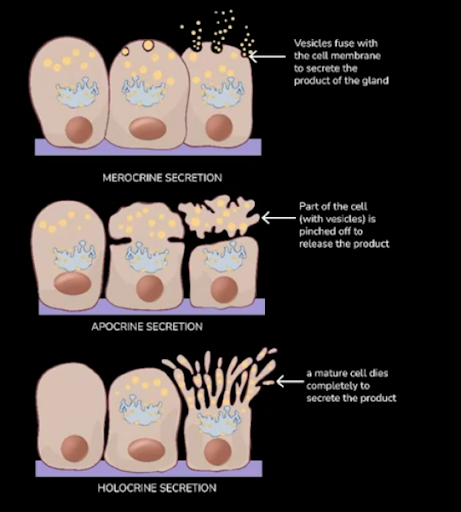Types of Sweat Glands in Skin
May 16, 2023
Navigate Quickly
Sweat Glands
Types of Skin Gland Secretions:
Location and Structure of Skin Glands
Eccrine gland
Apocrine gland
Eccrine Gland Disorders
Hyperhidrosis
Test for Hyperhidrosis
Miliaria (IMP)
To Remember
Apocrine Gland Disorders
Bromhidrosis vs Chromhidrosis
Fox Fordyce Disease/ Apocrine Miliaria
Hidradenitis Suppurativa (HS)
Predisposing factors
Syringomas:
Frequently Asked Questions

Sweat Glands
Small tubular structures of the skin that produce sweat are known as sweat glands, sometimes known as sudoriferous or sudoriferous glands, from the Latin sudor'sweat. Exocrine glands, which include sweat glands, generate and exude chemicals onto an epithelial surface through a duct.
Read this blog further to get a quick overview of this important topic for dermatology and ace your NEET PG exam preparation.
Sweat Glands has 2 portions-Coiled portion and Duct portion
- Eccrine- If the duct directly opens over skin surface, it is k/a Eccrine sweat gland
- Apocrine- If duct opens along with hair follicle, it is k/a Apocrine sweat gland
Location and Structure of Skin Glands

Eccrine gland
It Has two coiled structures, One below dermis - Sweat gland and Another in Epidermis - Acrosyringium, It Opens directly into the skin
Apocrine gland
It is Single highly coiled structure which Opens into hair follicle
Eccrine vs Apocrine:
| Criteria | Eccrine Gland | Apocrine Gland |
| Location | All over body (more on palms and soles) | Axilla, groin, mammary area, umbilicus |
| Type of Secretion | Merocrine | Apocrine |
| Opening | Directly into skin | Into hair follicle |
| Innervation | Cholinergic | Adrenergic |
| Secretion | Watery | Viscous |
| Role | Sweating/ Thermoregulation | Body odor (no role in thermoregulation) |
| Onset of Activity | By birth | Puberty (Androgen dependent) |
Eccrine Gland Disorders
- Hyperhidrosis - Over sweating
- Hypo/ Anhidrosis - Less/ No sweating
- Miliaria - Blockage of Acrosyringium
- Neutrophilic Eccrine Hidradenitis - Seen in chemotherapy patients (characterized by painful red eruptions on trunk)
Hyperhidrosis

- Cause: Anxiety, stress, temperature differences
- Locations- on Palms - Palmoplantar, Axilla - Axillary (usually in post puberty)
Test for Hyperhidrosis

- Iodine is painted on the affected area then Starch is sprayed after that Black coloration is seen and Black dots are formed indicating hyperhidrosis.
- Treatment
- Aluminum hexachloride
- Formaldehyde
- Glutaraldehyde
- Oral anticholinergic
- Iontophoresis
- Botulinum toxin
- Surgery
- Iontophoresis-In this Two bowls are placed in water then Patient is allowed to put his hands into the bowls and then Current is passed to improve hyperhidrosis
Miliaria (IMP)
It is the Most common type of sweat gland disorder, It occurs due to Blockage in the Acrosyringium
- Types

- Miliaria Crystallina - Stratum corneum
- Miliaria Rubra - Stratum spinosum
- Miliaria Profunda - Basal layer (dermo-epidermal junction)
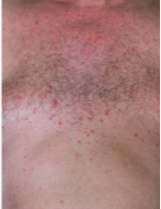
|
Miliaria Crystallina |
Miliaria Rubra |
Miliaria Profunda |
|
|
|
- Treatment
- Cooling advice
- Calamine lotion can be given
To Remember
- Miliaria rubra may get infected sometimes then it is called Miliaria pustulosa
- Pustules are seen.
- Usually, infecting bacteria is Staphylococcus aureus.
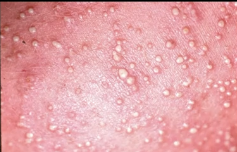
Related Articles :
Apocrine Gland Disorders
- Bromhidrosis
- Chromhidrosis
- Fox fordyce disease
- Hidradenitis Suppurativa
Bromhidrosis vs Chromhidrosis
|
Bromhidrosis |
Chromhidrosis |
|
|
Fox Fordyce Disease/ Apocrine Miliaria

- Reason: Apocrine gland is blocked
- On set: Puberty
- Gender: Female >> Male
- Site: Mostly Axilla
- Clinical presentation
- Skin colored raised discrete papules
- Itchy
Hidradenitis Suppurativa (HS)
Whole hair unit is affected, not only the apocrine gland.it is a Chronic inflammatory condition also known as Acne inversa (seen at inverse locations to acne) it occurs on the following Site: Axilla, groin, mammary, umbilicus. It mainly affects pubertal age group.
Predisposing factors
- Obesity
- Smoking
- DM
- Insulin resistance
- Metabolic syndrome
- Associations
- Follicular occlusion triad (HS, acne conglobata, dissecting cellulitis of scalp)
- Tetrad: Follicular occlusion triad + Pilonidal sinus
- Crohn's disease
To Remember: Severity staging of HS was given by Hurley
- Pathophysiology of HS
- Follicular occlusion and dilation
- Follicular rupture and inflammatory nodules and abscesses
- Chronic state with sinus tracts and scarring.
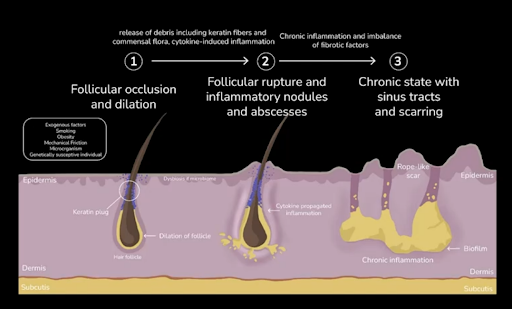
- Clinical presentation
- Polyporus Comedones (blocked sebaceous duct)
- Inflammatory papules
- Recurrent episodes
- If severe
- Abscess
- Multiple discharge sinuses
- Heals with scarring (Bridging/ rope scars)

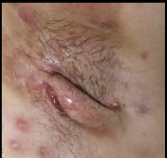
Bridging/ Rope Scars: They are seen because of the sinuses formed, as they leave behind the bridge lines between the follicles.

Syringomas:
It is a Rare condition. It is the Disorder of Eccrine sweat glands in which the patient develops skin-colored raised lesions which are Generally Asymptomatic. Most common site of occurrence of lesions is eyelids. These are Benign eccrine sweat gland duct tumors.

Frequently Asked Questions
Q: Who gave the Severity staging of HS?
Answer: It was given by Hurley.
Q: What is Hyperhidrosis?
Answer: Hyperhidrosis is Over-sweating.
Q: what are the causes of Hyperhidrosis?
Answer: Hyperhidrosis may be caused by Anxiety, stress, and/or temperature differences.
This is everything that you need to know about Acanthosis Nigricans for your dermatology preparation. For more interesting and informative blog posts like this download the PrepLadder App and keep reading our blog!

PrepLadder Medical
Get access to all the essential resources required to ace your medical exam Preparation. Stay updated with the latest news and developments in the medical exam, improve your Medical Exam preparation, and turn your dreams into a reality!
Top searching words
The most popular search terms used by aspirants
- NEET PG Dermatology
- NEET PG Strategy
PrepLadder Version X for NEET PG
Avail 24-Hr Free Trial
